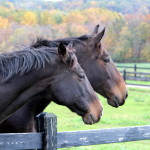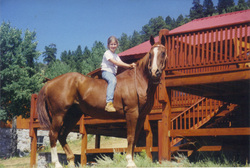I have noticed that learning seems to happen all at once for me. I try to be learning all the time, but it often feels as though it doesn’t quite stick until all at once I am exposed to new people, new ideas, or just a series of “breakthrough” moments.
This past week has been one of those times where all kinds of new, mind opening information came my way. First was the weekend at equine affair, a large horse expo with a packed schedule of lectures and demonstrations from some of the best trainers, clinicians, saddle makers, and other professionals from every area of the horse industry.
Then, as soon as I arrived home from Equine Affair, I was scheduled to participate in a clinic with Wendy Murdoch – a talented riding instructor who is also an expert in anatomy (both horse and human) as well as type of body work called Feldenkrais – which is simply about bringing awareness to one’s body and one’s movement. Wendy blends her expertise in anatomy and body work into her riding instruction for a truly unique learning experience.
So I have had a week full of watching demonstrations, sitting in on lectures, riding in a clinic, and having body work done on myself and my horse, not to mention the stack of new books and DVDs that I picked up.
Now you may be wondering why I titled this post “Less is More,” while I am talking about the huge amount of information I am taking in right now, and all the new things I am trying out with my horses and my riding.
From everything that happened in this past week, this has been my biggest insight – less really is more.
I always thought “less is more” was a nice catch phrase but I never gave much sincere thought to those words. However the more I discover about horses, riding, and even life in general, the more I realize that there is real truth and meaning to that phrase.
It is often through doing less and choosing the simple solution that we actually advance further and experience bigger breakthroughs in whatever we are trying to accomplish.
For example, during the clinic with Wendy, she made about a 1mm shift in the positioning of my upper body and I instantly felt more soft and fluid as I rode.
As I listened to Mark Rashid (one of the clinicians at Equine Affair) I started to realize that his message was really about finding an inner softness and how that once we can find that “softness” we have far more ability to communicate and direct the horse than we ever do through muscle and strength. That’s a pretty simple message.
The more I pondered what I was learning, the more I realized that the best rides I have – where I feel a big improvements in my horse, or I have a major breakthrough in something I have been working on training – are usually the rides where I get on, work slow and easy on a few things, ask for something new or something that has been challenging, then when they get it, I get back off – I do less, but I end up with more.
I also thought back to when I discovered the nathe bit – a simple bit constructed of a straight piece of soft, very flexible rubber. Well over half the horses that I have tried with the nathe bit loved it and became more relaxed and responsive. Again, less bit but more effective.
This extends to life outside of the barn and the arena as well, because when we can slow down and do less, but give greater focus and attention to what we are doing that is when the magic really happens.















9 Responses
lovely piece Callie – you’ve had a very insightful week of learning, beutifully shared.
Sound s as if you have had a lot to take in this week there is so much you can learn with and about horses I guess you can never stop learning really . Glad u had a good time. thanks for sharing with us .
Regards Bridget x
Beautiful affirmation,
Gorgeous scenery,
Wise soul.
Thank you so much for sharing.
I concur with the others~ a lovely piece and lots of truth in it that applies to all aspects of life. Happy Thanksgiving Callie!!
I have found myself thinking the same thing. More is not always better. The truth so often simply in the basics, in harmony, not more.
Love your articles Callie. Related to this, I have a young OTTB who struggles with confidence. I often dismount immediately after a great give from him; whether it was an amazing canter depart or just a soft ride or willing jump. I just quit right then. But have received some comments that perhaps this is not good leadership, that I am teaching him to quit and should at least go to something else, like walk around before I dismount; however, I see it as a release and reward. We have a good connection and he is getting easier by the ride. Confidence is greatly improved since we began; I don’t mind a horse that is more willing to stop and slow down. thought on this?
Hi Colleen, we always say that the million dollar question is ‘when should you quit a session?’ I don’t have the perfect answer but it is usually a good idea to end on a good note. I would agree with you on this!
-Julia Burdy, CRK Training Community Manager